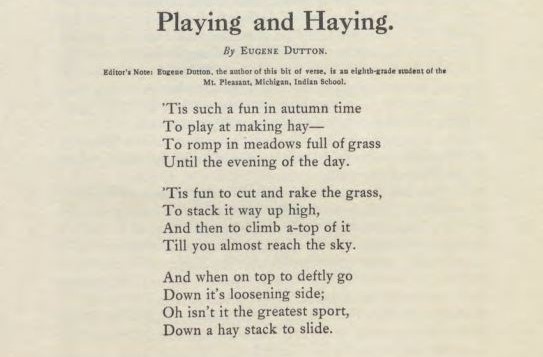Playing and Haying
By Eugene Dutton (Anishinaabe)[1]
Annotations by Jessica Cory

‘Tis such a fun in autumn time To play at making hay— To romp in meadows full of grass Until the evening of the day. ‘Tis fun to cut and rake the grass, To stack it way up high, And then to climb a-top of it Till you almost reach the sky. And when on top to deftly go Down it’s [sic] loosening side; Oh isn’t it the greatest sport, Down a hay stack to slide.
Dutton, eugene. “Playing and haying.” The REd Man 3 no. 5 (December 1910): 146.
[1] Dutton was noted by a local newspaper as being Chippewa. Today, the term used for Chippewa is Ojibwe. The Ojibwe . . . refer to themselves in their original language as the Anishinaabe, or “the people,” thus the changes seen here.
Contexts
Dutton’s poem was published in The Red Man, a publication of The Carlisle Indian Industrial School. Dutton, however, did not attend The Carlisle School, as the editor’s note clarifies, instead attending Mount Pleasant Indian Industrial School. Because the Carlisle School published this Native student’s poem and he attended another residential school that was likely responsible for sharing his work, we should recognize how power and censorship shape such texts.
On the author: The Mount Pleasant Indian Industrial School has very limited digital records, and I was only able to find that Dutton’s guardians were his grandparents and that several of his siblings also attended Mount Pleasant School. However, I was able ascertain some information about Eugene Dutton from local newspapers. In June of 1912, the Isabella County Enterprise evidences Dutton performing in school choir event. The next year, in October of 1913, the same newspaper reports that “Eugene Dutton…of Mackinaw Island” [now commonly called Mackinac Island] was visiting “the Government School.” Nothing else is printed of him until July 10, 1925 when he appears on the front page of the Isabella County Enterprise and on page 3 of the Clare Sentinel. Both mentions note that he was “formerly [a] pitcher for the Mt. Pleasant Indian school [baseball] team” (1) and pitched for the “North Branch Indians” in their game against the “Delwin Indians.” (3) The baseball game was part of a Fourth of July picnic held the previous week “by the Indians east and north of Rosebush in the Chatfield grove” (3). His last mentions in the newspaper occur June 3, 1930, when he appears on pages one and three of the Mount Pleasant Daily Times; these are also the only public findings of his tribal affiliation. In the front page article, “Chippewa Indian Tribe Sues Federal Government For Large Sum Under Alleged Provisions of Aged Treaty,” Dutton is one of two names nominated to become a temporary Tribal chairman. He did not, however, win that role and was instead “elected for the position as assistant to the secretary” (3).
Interestingly, the 1913 mention of Dutton being “of Mackinaw Island” was not able to be confirmed nor disconfirmed through historical records, as his birthplace was always listed simply as “Michigan.” For most of his life though, records do show that he primarily lived in Saginaw, Michigan, where the Isabella Reservation for the Saginaw Chippewa Tribe of Indians is located.
Resources for Further Study
- Adrian explores how the Mount Pleasant Indian Industrial School has affected the Saginaw Chippewa Tribe.
- Because Dutton was noted as being “of Macinaw Island,” information on the Mackinac Bands of Chippewa and Ottawa Indians may be helpful to understanding his background.
- John Crampton provides a first-person account of life at the Mount Pleasant school.
- For additional insight regarding boarding schools and how they affected Native children, please see my other work.
Pedagogy
The name “Chippewa” is used less frequently than the terms “Ojibwe” and “Anishinaabe” (sometimes spelled with one ‘a’) nowadays, so in searching for lesson plans, the latter two terms will likely need to be included in search terms.
- The National Endowment for the Humanities has some excellent lesson plans for teaching about Chippewa/Ojibwe, Anishinaabe cultures.
- The Saginaw Chippewa Tribe also has created several lesson plans on the residential school system.
Contemporary Connections
While the Saginaw Chippewa Tribe was awarded a grant to install fencing around two buildings that were part of the Mount Pleasant Boarding School, part of the fencing was destroyed by vandals trying to access the empty buildings, which are on the National Register of Historic Places in Sept. 2020. The Tribe also has regular commemorations to remember the closing of the school.